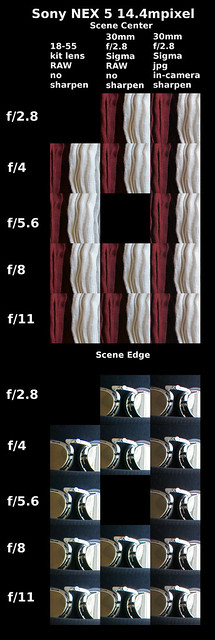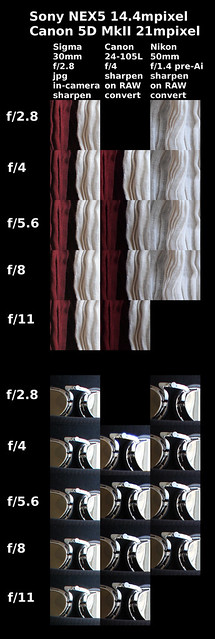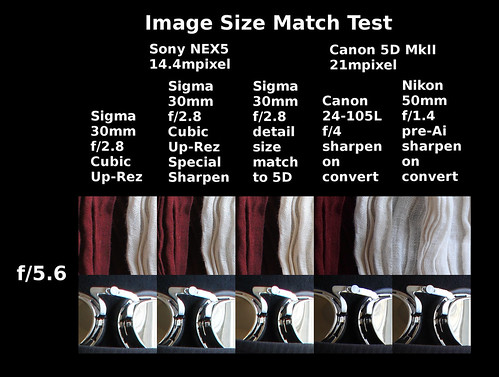Le Salon Fantastique is done and over. It was a great show and everyone seemed to have a good time.
I went on Sunday with my camera. I hauled my Canon 7D/24-105L f/4 kit along with a strobe and umbrella. It's nearly Friday and I'm still sore from holding what's becoming a heavy brick. It's my age and I know it.
So... I've been thinking and researching a bit. I need a small kit that can deliver outstanding resolution, control and performance like my big cameras. To test the idea of downsizing I bought a pair of Sigma EX DN lenses. I also wanted to see just how good or bad the Sony NEX kit lens is, particularly compared with the industry standard for overall performance, the 24-105L Canon.
Here is the test subject in all it's glory. I was looking for very fine textures as well as shadow and highlight details.
Test One - Sony 18-55SEL kit lens vs Sigma 30mm EX DN

Each 300x300 pixel section is real 100% pixel-level output. This test was broken into two parts, where the first two columns of images are Sony RAW conversions to jpg without sharpening. This is what the sensor and related electronics puts out. The second part/third column shows in-camera jpg default sharpening using "standard" image tones.
Analyzing the images carefully I see that the Sigma 30mm EX DN is an outstanding lens and deserving of it's reputation. It's nice and sharp and contrasty from wide open. The Sony SEL 18-55 kit lens matches the Sigma at f/8, but that's just about it. It's not a bad lens, considering it's price. You can clearly see it's limitations. Used carefully, however, it can help a photographer make amazingly crisp images.
Test Two - Sony Sigma 30mm vs Canon 5D MkII 24-105L and Nikon 50mm f/1.4 pre-Ai

Analyzing the images carefully shows how good the Canon 5D MkII remains. The only curious thing is how the L-glass treats the edge/off-center highlight areas at f/4. It's a little strange. What's going on here?
We also see how wonderful the Nikon Nikkor 50mm f/1.4 pre-Ai remains today. I am convinced there is no reason not to use old glass on new cameras. With focus peaking as found on many mirrorless cameras these lenses can be good values for the money.
The Sony/Sigma setup is quite good... BUT... the scene size was the same in these three tests and the smaller sensor'd Sony gives slightly smaller 100% pixel images. 14.4mpixel files are 4/5ths the size of 21mpixel output. I needed to move in closer to the subject by 1/5th the distance of the first setup. Which leads to...
Test Three - Uprez'd and 1/5th closer Sony/Sigma vs Canon 5D MkII 24-105L and Nikon 50mm f/1.4 pre-Ai

This is where things get really interesting.
A straight cubic up-rez on the 14.4mpixel file to Canon 5D MkII file sizes shows things look pretty darned good in the old Sony camp. These images show a little less "resolution" than moving the camera 1/5th the distance closer to the subject.
Images at 1/5th the distance seem to do well enough to illustrate that Sony pixels are as good as Canon pixels (if you follow the wrangling that goes on over on Canon Rumors, you'll understand what I'm talking about). The Nikon lens'd images remain outstanding, as do the native 24-105L works. Nothing changed in that part of the test.
What's amazing to me and what really has potential is that up-rezing the Sony NEX5(original) 14.4mpixel in-camera sharpened jpg image to 5D MkII file sizes... and then adding a little (not-so) Secret Sauce... et voila! Can you really tell any difference between my NEX5 up-rez with Gimp/FX-Foundary Sharpening and my 21mpixel DSLR images?
Make sure you enlarge these to 100% to clearly see what's going on here.
So what have I proven? Well, several things, actually.
First, an old APS-C 14.4mpixel sensor can still perform remarkably well.
Second, my thoughts on how Lightroom and Photoshop sharpen files at the print stage seem to play out. You can take a small Sony NEX5 file and make it look good by carefully up-rez'ing it at or just before making a large print. Yes, you will not have all the resolution "real" of a native sized-sensor, but... the eye can interpret local contrast as resolution and a good work can "appear" to be as good as something from a larger sensor, even when pixel peeping. You have to be careful, but you can do it. Using this approach on a Canon 5D MkII file can yield huge files of incredible quality.
Third, ... well... I'll save this for another post... so stay tuned.
I went on Sunday with my camera. I hauled my Canon 7D/24-105L f/4 kit along with a strobe and umbrella. It's nearly Friday and I'm still sore from holding what's becoming a heavy brick. It's my age and I know it.
So... I've been thinking and researching a bit. I need a small kit that can deliver outstanding resolution, control and performance like my big cameras. To test the idea of downsizing I bought a pair of Sigma EX DN lenses. I also wanted to see just how good or bad the Sony NEX kit lens is, particularly compared with the industry standard for overall performance, the 24-105L Canon.
Here is the test subject in all it's glory. I was looking for very fine textures as well as shadow and highlight details.
Test One - Sony 18-55SEL kit lens vs Sigma 30mm EX DN

Each 300x300 pixel section is real 100% pixel-level output. This test was broken into two parts, where the first two columns of images are Sony RAW conversions to jpg without sharpening. This is what the sensor and related electronics puts out. The second part/third column shows in-camera jpg default sharpening using "standard" image tones.
Analyzing the images carefully I see that the Sigma 30mm EX DN is an outstanding lens and deserving of it's reputation. It's nice and sharp and contrasty from wide open. The Sony SEL 18-55 kit lens matches the Sigma at f/8, but that's just about it. It's not a bad lens, considering it's price. You can clearly see it's limitations. Used carefully, however, it can help a photographer make amazingly crisp images.
Test Two - Sony Sigma 30mm vs Canon 5D MkII 24-105L and Nikon 50mm f/1.4 pre-Ai

Analyzing the images carefully shows how good the Canon 5D MkII remains. The only curious thing is how the L-glass treats the edge/off-center highlight areas at f/4. It's a little strange. What's going on here?
We also see how wonderful the Nikon Nikkor 50mm f/1.4 pre-Ai remains today. I am convinced there is no reason not to use old glass on new cameras. With focus peaking as found on many mirrorless cameras these lenses can be good values for the money.
The Sony/Sigma setup is quite good... BUT... the scene size was the same in these three tests and the smaller sensor'd Sony gives slightly smaller 100% pixel images. 14.4mpixel files are 4/5ths the size of 21mpixel output. I needed to move in closer to the subject by 1/5th the distance of the first setup. Which leads to...
Test Three - Uprez'd and 1/5th closer Sony/Sigma vs Canon 5D MkII 24-105L and Nikon 50mm f/1.4 pre-Ai

This is where things get really interesting.
A straight cubic up-rez on the 14.4mpixel file to Canon 5D MkII file sizes shows things look pretty darned good in the old Sony camp. These images show a little less "resolution" than moving the camera 1/5th the distance closer to the subject.
Images at 1/5th the distance seem to do well enough to illustrate that Sony pixels are as good as Canon pixels (if you follow the wrangling that goes on over on Canon Rumors, you'll understand what I'm talking about). The Nikon lens'd images remain outstanding, as do the native 24-105L works. Nothing changed in that part of the test.
What's amazing to me and what really has potential is that up-rezing the Sony NEX5(original) 14.4mpixel in-camera sharpened jpg image to 5D MkII file sizes... and then adding a little (not-so) Secret Sauce... et voila! Can you really tell any difference between my NEX5 up-rez with Gimp/FX-Foundary Sharpening and my 21mpixel DSLR images?
Make sure you enlarge these to 100% to clearly see what's going on here.
So what have I proven? Well, several things, actually.
First, an old APS-C 14.4mpixel sensor can still perform remarkably well.
Second, my thoughts on how Lightroom and Photoshop sharpen files at the print stage seem to play out. You can take a small Sony NEX5 file and make it look good by carefully up-rez'ing it at or just before making a large print. Yes, you will not have all the resolution "real" of a native sized-sensor, but... the eye can interpret local contrast as resolution and a good work can "appear" to be as good as something from a larger sensor, even when pixel peeping. You have to be careful, but you can do it. Using this approach on a Canon 5D MkII file can yield huge files of incredible quality.
Third, ... well... I'll save this for another post... so stay tuned.

No comments:
Post a Comment